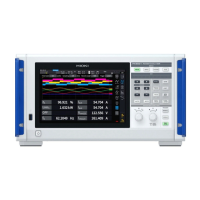197
Functional Specications
Calculation function
(1) Rectication method
Function The voltage and current values used to calculate apparent and reactive power and power
factor can be selected.
Operating mode RMS, mean (Can be selected for each wiring conguration’s voltage and current.)
(2) Scaling
Function The VT ratio and CT ratio can be set so that they can aect measured values.
VT (PT) ratio Can be set for each wiring conguration.
0.00001 to 9999.99
(The settings cannot be congured such that (VT
×
CT) is greater than 1.0E+06.)
CT ratio Can be set for each channel.
0.00001 to 9999.99
(The settings cannot be congured such that (VT
×
CT) is greater than 1.0E+06.)
Display While the scaling enabled, the [VT] and [CT] icons are displayed on the screen.
(3) Average (AVG)
Function All instantaneous measured values, including harmonics, are averaged.
(Excluding peak values, integrated values, and harmonic data during the 10 ms data
refreshing.)
Voltage (U), current (I), and power (P) values are averaged. Calculated values are computed
from those values.
For harmonics, instantaneous values are averaged for RMS values and content percentages.
The phase angles are calculated from the average results of FFT-processed real and
imaginary parts.
The phase dierence, distortion, and unbalance rate are calculated from data obtained by the
above averaging.
The ripple factor is calculated from data computed by averaging the dierence between the
positive and negative peak values.
Measured motor-analysis values are calculated from data computed by averaging the Ch. A to
Ch. H values.
Operating mode O, exponential average, moving average
Operation
Exponential average Data is exponentially averaged using a time constant specied by the
data refresh intervals and the exponential average response speed.
During average operation, averaged data aects all analog output and
save data.
Moving average Averaging is performed for the moving averaging count at the data
refresh interval to update the output data. Same as the data refresh
interval without averaging
Exponential
average response
speed
Averaging count Fast Mid Slow
10 ms 0.1 s 0.8 s 5 s
50 ms 0.5 s 4 s 25 s
200 ms 2.0 s 16 s 100 s
These values indicate the time required for the nal stabilized value to converge on the range
of
±
1% when the input changes from 0% to 90% of the range.
Although harmonic data is not averaged when the data refresh rate is set at 10 ms, harmonic
data contained in basic measurement items is averaged using the exponential average
coecient every 10 ms.
Moving averaging
count
8, 16, 32, 64 times
Specications

